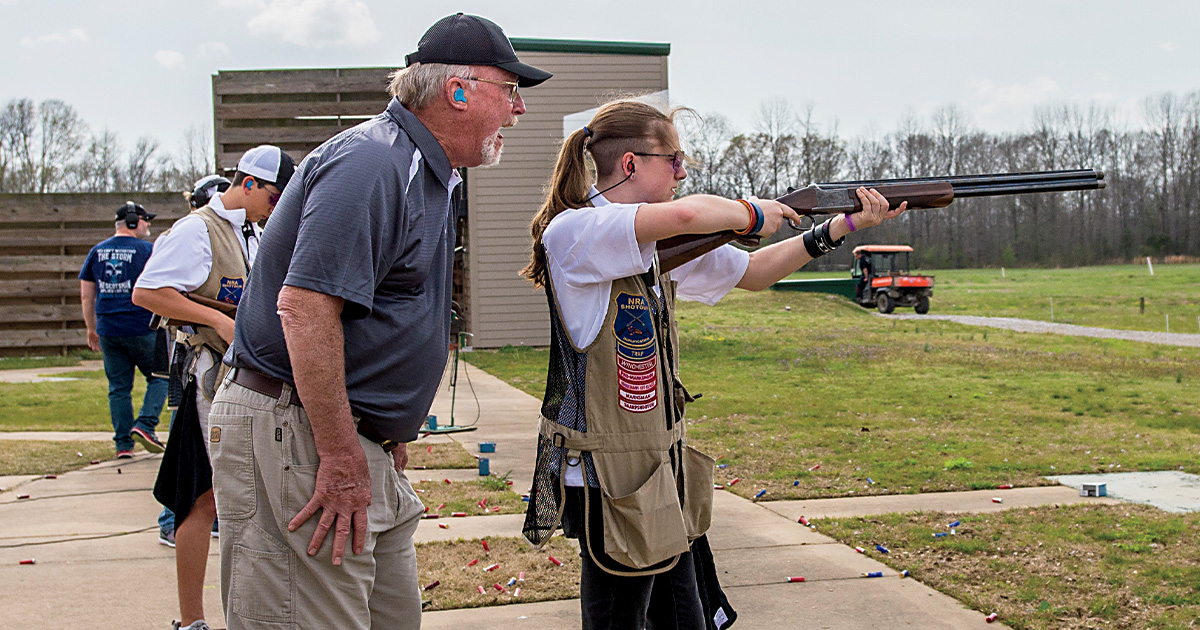Shotgunning: Young Guns
Youth shooting programs teach discipline and safety while supporting conservation
Youth shooting programs teach discipline and safety while supporting conservation

Youth shooting teams are co-ed, giving girls and boys an opportunity to compete in shotgun sports. Ducks Unlimited supports youth shooting programs at schools and clubs through its Team Resource Assistance Program (T.R.A.P.).
Scholastic clay target shooting continues to grow. Participating students learn the benefits of teamwork, focus, and dedication by competing in shotgunning disciplines. They practice gun safety and marksmanship while representing their school, and they can earn varsity letters. Scholastic shooting sports can also rejuvenate aging gun clubs, create a pool of candidates for hunter recruitment efforts, and provide a steady stream of conservation funding. The teams are co-ed, the sport is challenging, and the programs have a spotless safety record.
Two leagues support over 3,200 shooting teams: the USA Clay Target League (USACTL), which is entirely school-based and begins in sixth grade, and the Scholastic Clay Target Program (SCTP), whose teams can be either school-based or formed as clubs that admit eligible students regardless of where they attend school. SCTP also serves as the official feeder program for USA Shooting, conducting clinics and competitions in international trap and skeet and participating in Junior Olympic trials and international competitions.
USACTL boasts over 49,000 members on 1,647 teams. SCTP’s 1,600 teams comprise 21,000 athletes. Last year 2,456 shooters competed in SCTP Nationals—the multi-day event that saw more than 2 million targets thrown at the Cardinal Shooting Center in Marengo, Ohio.
Both leagues include “join a team” and “start a team” tools on their websites to help you get involved. Neither program requires prior shooting experience. All a young shooter needs are eye and ear protection, a shell pouch or vest, and a shotgun. While most participants who want to take the sport seriously eventually invest in a target gun, many start with field guns, and many shoot them for their entire scholastic careers. The best field gun to use for clays is usually one that is as long and as heavy as the shooter can manage, because it will swing smoothly and have less recoil than a short, light gun.
Scholastic leagues also need adult volunteers to make these programs work. Both leagues offer coaching certifications and continuing education. Helping a team can be rewarding, and it teaches you a great deal about shooting and helping people learn to shoot.
Clay target shooting is expensive. The average USACTL competitor goes through nearly 2,000 shells a year. Tournament entry fees add up quickly too. To help teams defray costs, Ducks Unlimited started its Team Resource Assistance Program (T.R.A.P.) in 2020 to provide discounted merchandise and professionally designed marketing materials for club fundraising activities. To date, the program has helped over 580 teams and 20,000 shooters. “Coaches sell this program for us,” says DU Manager of Youth Engagement Programs Justin Aycock. “We’ll be talking to an interested coach at a shoot, and another who has already participated will encourage them to sign up.”
Aycock says the program is important to DU’s mission for a number of reasons. He points out that recreational shooters contribute to conservation through Pittman-Robertson Act (PR) excise taxes every time they buy guns or ammunition. USACTL estimates that its teams’ total expenditures generated $7 million in PR funds in 2023 alone, and that its average shooter generates three times more PR money in a year than the average hunter does. Furthermore, many scholastic shooters go on to become adult target-shooting enthusiasts and lifelong PR contributors. A recent survey conducted by Responsive Management showed that 87 percent of nonhunting target shooters supported PR money going toward conservation. Aycock says T.R.A.P. has helped archery and rifle programs too. “If it bangs or twangs, we’ll support it,” he says.
While target shooting doesn’t always lead to hunting participation, scholastic shooters make excellent candidates for hunter recruitment. Pass It On—Outdoor Mentors began partnering with state agencies to offer mentored hunts to scholastic shooting team members in Kansas in 2018. The organization has since expanded its operations to Iowa, Wisconsin, Kentucky, and, perhaps soon, Missouri. “These kids are the low-hanging fruit of R3 (recruitment, retention, reactivation),” says Pass It On founder Mike Christensen. “They are comfortable with guns, they can handle them safely, and they can shoot. That removes several of the hurdles of recruiting new hunters.” A young person may or may not choose to hunt, but participating in shooting sports increases the chances that they will.
Ducks Unlimited uses cookies to enhance your browsing experience, optimize site functionality, analyze traffic, and deliver personalized advertising through third parties. By continuing to use this site, you agree to our use of cookies. View Privacy Policy